An Integrated Microfabricated Chip with Double Functions as an Ion Source and Air Pump Based on LIGA Technology
Abstract
:1. Introduction
2. Device Design and Fabrication
2.1. Design of the Integrated System
2.2. Material Choice
- (1)
- The needle-to-cylinder electrodes must be conductive materials and strong enough to resist the erosion of air discharge;
- (2)
- The bottom and upper substrates should be an electrical insulator so as to accomplish the electrical isolation from the needle and the cylinders; and
- (3)
- The upper substrate should be transparent to observe the discharging phenomenon.
2.3. Fabrication Process
- (a)
- Photoresist coating: The photoresist is chosen as PMMA of AR-P 6510 style from ALLRESIST in Germany. The baking temperature is 160 °C lasting 50 min.
- (b)
- Exposure: The time for the X-ray exposure is 2.2 h.
- (c)
- Developing: The developing agent is R600-56, and the developing time is eight hours.
- (d)
- Sputtering copper: The copper sulfate solution is used with the density of 200 g/L. The density of sulfate is 100 mL/L. The electroplating current is 200 mA at room temperature, and the lasting time under the electroplating current is 24 h. The height of electroplated Cu for the cylinder and the needle is 1 mm and 20 μm, respectively.
- (e)
- Lapping: The grinding process is finished by a UNIPOL-802 grinding machine from MIT Company. The rotational speed is 50 r/min until the grinding process is finished.
- (f)
- Removing the photoresist: The photoresist is removed by the Remover AR600-70.
- (g)
- Removal of the Ti substrate: The Ti substrate is removed by 30% hydrofluoric acid with adensity of 20 mL/L for 8 h.
3. Results and Discussion
3.1. The Discharge and Ionic Wind Velocity
3.2. The Sample Injection and Ionization
4. Conclusions
Acknowledgments
Author Contributions
Conflicts of Interest
References
- Chen, Y.; Tang, F.; Li, T.G.; He, J.M.; Abliz, Z.; Liu, L.T.; Wang, X.H. Application of Factor Analysis in Imaging Mass Spectrometric Data Analysis. Chin. J. Anal. Chem. 2014, 42, 1099–1103. [Google Scholar] [CrossRef]
- Tang, F.; Bi, Y.; He, J.M.; Li, T.G.; Abliz, Z.; Wang, X.H. Application of super-resolution reconstruction of sparse representation in mass spectrometry imaging. Rapid Commun. Mass Spec. 2015, 29, 1178–1184. [Google Scholar] [CrossRef] [PubMed]
- Tang, F.; Chen, Y.; Li, T.G.; He, J.M.; Abliz, Z.; Huang, G.; Wang, X.H. A quick and effective multivariate statistical strategy for imaging mass spectrometry. Chin. Chem. Lett. 2014, 25, 1331–1335. [Google Scholar] [CrossRef]
- Takáts, Z.; Wiseman, J.M.; Gologan, B.; Cooks, R.G. Mass Spectrometry Sampling under Ambient Conditions with Desorption Electrospray Ionization. Science 2004, 306, 471–473. [Google Scholar] [CrossRef] [PubMed]
- Cody, R.B.; Laramée, J.A.; Durst, H.D. Versatile new ion source for the analysis of materials in open air under ambient conditions. Anal. Chem. 2005, 77, 2297–2302. [Google Scholar] [CrossRef] [PubMed]
- McEwen, C.; Gutteridge, S. Analysis of the Inhibition of the Ergosterol Pathway in Fungi Using the Atmospheric Solids Analysis Probe (ASAP) Method. J. Am. Soc. Mass Spectrom. 2007, 18, 1274–1278. [Google Scholar] [CrossRef] [PubMed]
- Liu, Y.; Lin, Z.; Zhang, S.; Yang, C.; Zhang, X. Rapid screening of active ingredients in drugs by mass spectrometry with low-temperature plasma probe. Anal. Bioanal. Chem. 2009, 395, 591–599. [Google Scholar] [CrossRef] [PubMed]
- Guo, C.A.; Tang, F.; Chen, J.; Wang, X.H.; Zhang, S.C.; Zhang, X.R. Development of dielectric-barrier-discharge ionization. Anal. Bioanal. Chem. 2015, 407, 2345–2364. [Google Scholar] [CrossRef] [PubMed]
- Wang, H.; Sun, W.J.; Zhang, J.S.; Yang, X.H.; Lin, T.; Ding, L. Desorption corona beam ionization source for mass spectrometry. Analyst 2010, 135, 688–695. [Google Scholar] [CrossRef] [PubMed]
- Zhan, X.F.; Zhao, Z.J.; Yuan, X.; Wang, Q.H.; Li, D.D.; Xie, H.; Li, X.M.; Zhou, M.G.; Duan, Y.X. Microwave-Induced Plasma Desorption/Ionization Source for Ambient Mass Spectrometry. Anal. Chem. 2013, 85, 4512–4519. [Google Scholar] [CrossRef] [PubMed]
- Liu, K.; Tang, F.; Wang, X.H.; Wei, X.Y.; Xiong, J.J. Novel Chemical Ion Source for a High-Field Asymmetric Waveform Ion Mobility Spectrometer Used under Ambient Conditions. Acta Phys. Chim. Sin. 2009, 25, 1662–1670. [Google Scholar]
- Rahman, M.M.A.; Abdelsalam, F.W. Design and fabrication of a spherical configuration ion source. Europhys. Lett. 2012, 98, 155–161. [Google Scholar]
- Ding, X.L.; Zhan, X.F.; Yuan, X.; Zhao, Z.J.; Duan, Y.X. Microfabricatedglow discharge plasma (MFGDP) for ambient desorption/ionization mass spectrometry. Anal. Chem. 2013, 85, 9013–9020. [Google Scholar] [CrossRef] [PubMed]
- Snyder, D.T.; Pulliam, C.J.; Ouyang, Z.; Cooks, R.G. Miniature and Fieldable Mass Spectrometers: Recent Advances. Anal. Chem. 2016, 88, 2–29. [Google Scholar] [CrossRef] [PubMed]
- Schmid, S.; Dohn, S.; Boisen, A. Real-Time Particle Mass Spectrometry Based on Resonant Micro Strings. Sensors 2010, 10, 8092–8100. [Google Scholar] [CrossRef] [PubMed] [Green Version]
- Huo, X.M.; Tang, F.; Chen, J.; Zhang, X.H.; Wang, X.H. Characterization of the impact of the ejection slit on miniature rectilinear ion trap analysis. Int. J. Mass Spectrom. 2016, 399, 44–50. [Google Scholar] [CrossRef]
- Li, H.; Zeng, D.C.; Liu, J.Y.; Chen, Z.C. Realization of DC atmospheric pressure glow discharge without external airflow. Vacuum 2015, 113, 28–35. [Google Scholar] [CrossRef]
- Li, H.; Guo, C.Q.; Li, Y.K.; Hong, X.L.; Zhu, J.M.; Chen, Z.C. Effect of atmospheric-pressure discharge type on ionic wind velocity for needle-to-cylinder electrode. J. Vac. Sci. Technol. A 2016, 34, 1–8. [Google Scholar] [CrossRef]
- Li, H.; Wei, C.Y.; Liu, C.X.; Shen, X.H.; Chen, Z.C. Design and Experiment of a needle-to-cylinder electrode structure realizing the negative DC glow discharge in ambient air. Spectrosc. Spect. Anal. 2014, 34, 1797–1800. [Google Scholar]
- Martins, A.A. Simulation of a wire-cylinder-plate positive corona discharge in nitrogen gas at atmospheric pressure. Phys. Plasmas 2012, 19. [Google Scholar] [CrossRef]
- Lee, S.J.; Li, L.; Kwon, K.; Kim, W.; Kim, D. Parallel integration of ionic wind generators on PCBs for enhancing flow rate. Microsyst. Technol. 2015, 21, 1465–1471. [Google Scholar] [CrossRef]
- Hattori, K.; Ishil, Y.; Tobari, H.; Ando, A.; Inutake, M. Stabilization of DC atmospheric pressure glow discharge by a fast gas flow along the anode surface. Thin Solid Films 2006, 506, 440–443. [Google Scholar] [CrossRef]
- Ren, C.S.; Ma, T.C.; Wang, D.Z.; Zhang, J.L.; Wang, Y.N. A study of cross-gas-flow to stabilize an atmospheric pressure glow plasma in a multi-pin-to-multi-cupped-plane negative corona discharge. J. Electrostat. 2006, 64, 23–28. [Google Scholar] [CrossRef]
- Li, X.C.; Zhao, H.H.; Jia, P.Y. Characteristics of a Normal Glow Discharge Excited by DC Voltage in Atmospheric Pressure Air. Plasma Sour. Sci. Technol. 2013, 15, 1149–1153. [Google Scholar] [CrossRef]
- Staack, D.; Farouk, B.; Gutsol, A.; Fridman, A. Characterization of a dc atmospheric pressure normal glow discharge. Plasma Sour. Sci. Technol. 2005, 14, 700–711. [Google Scholar] [CrossRef]
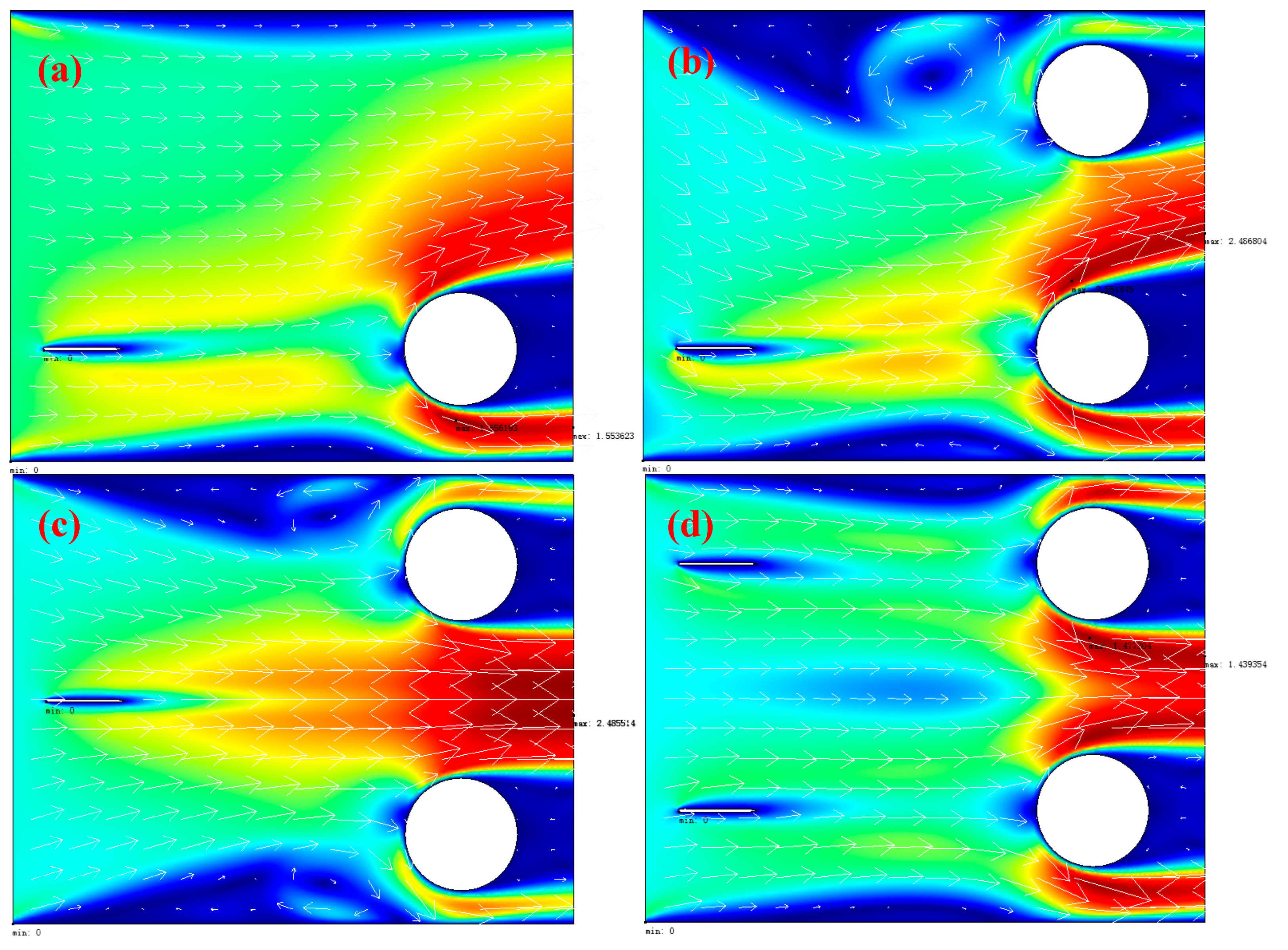
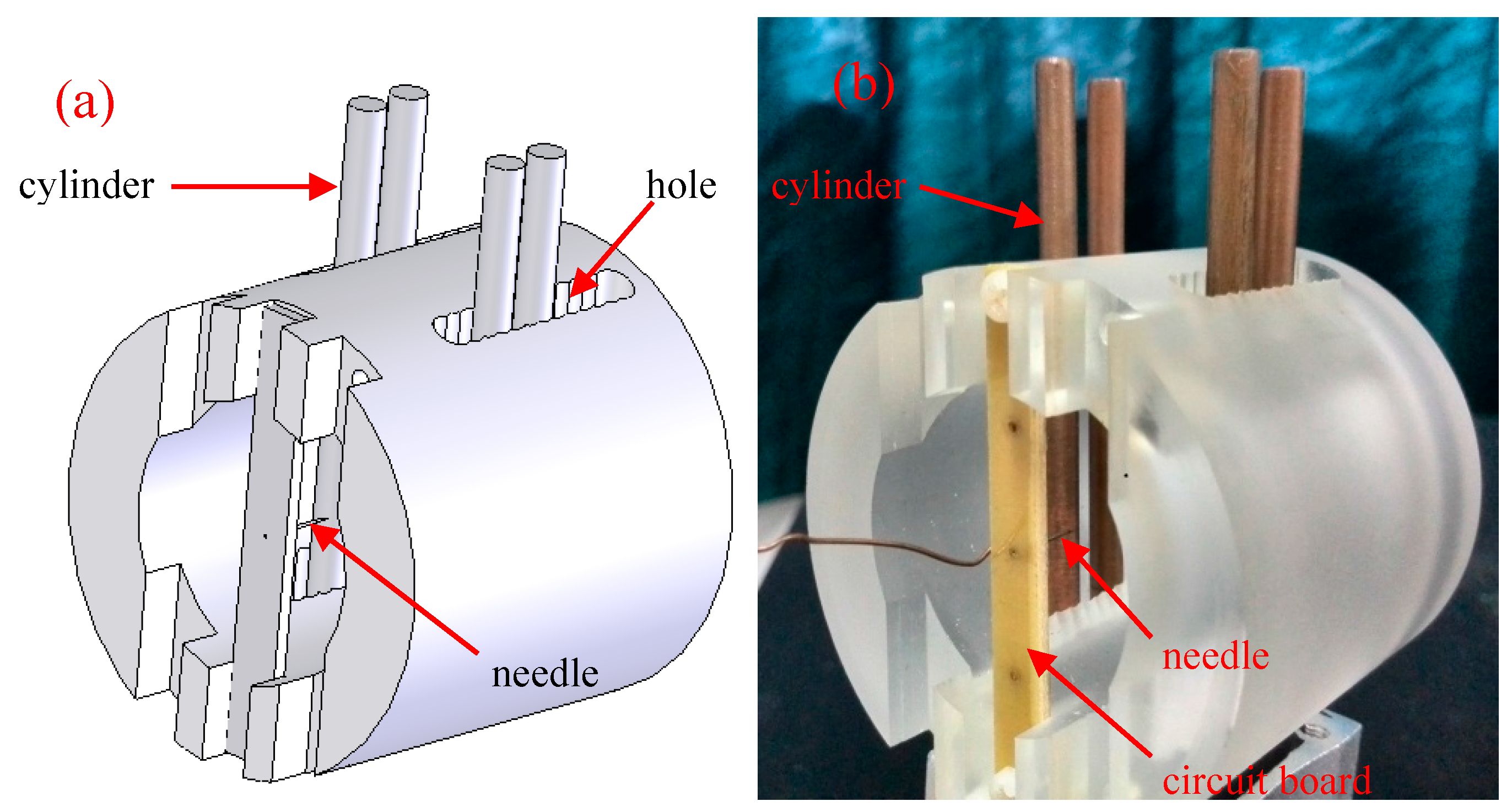
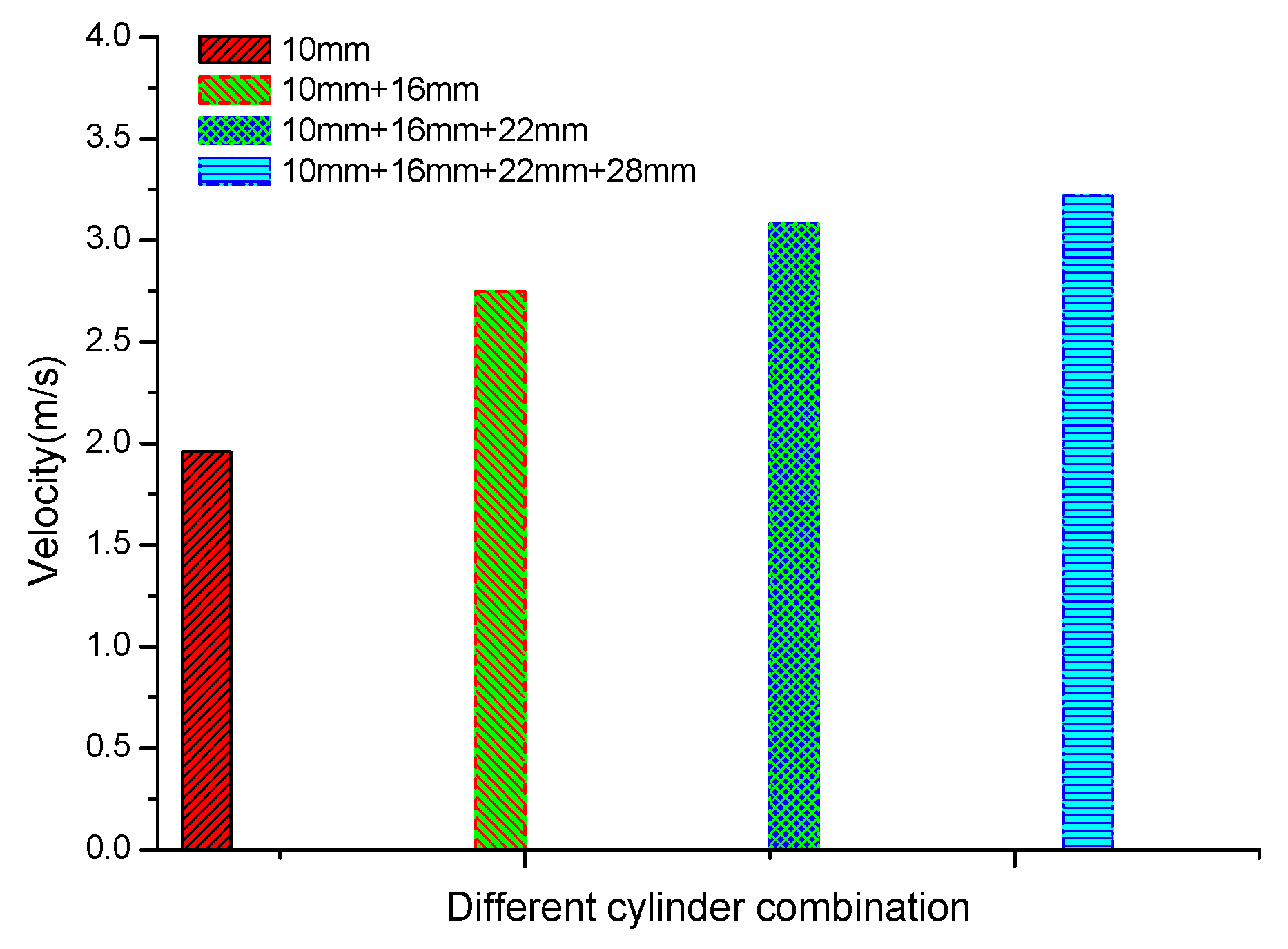
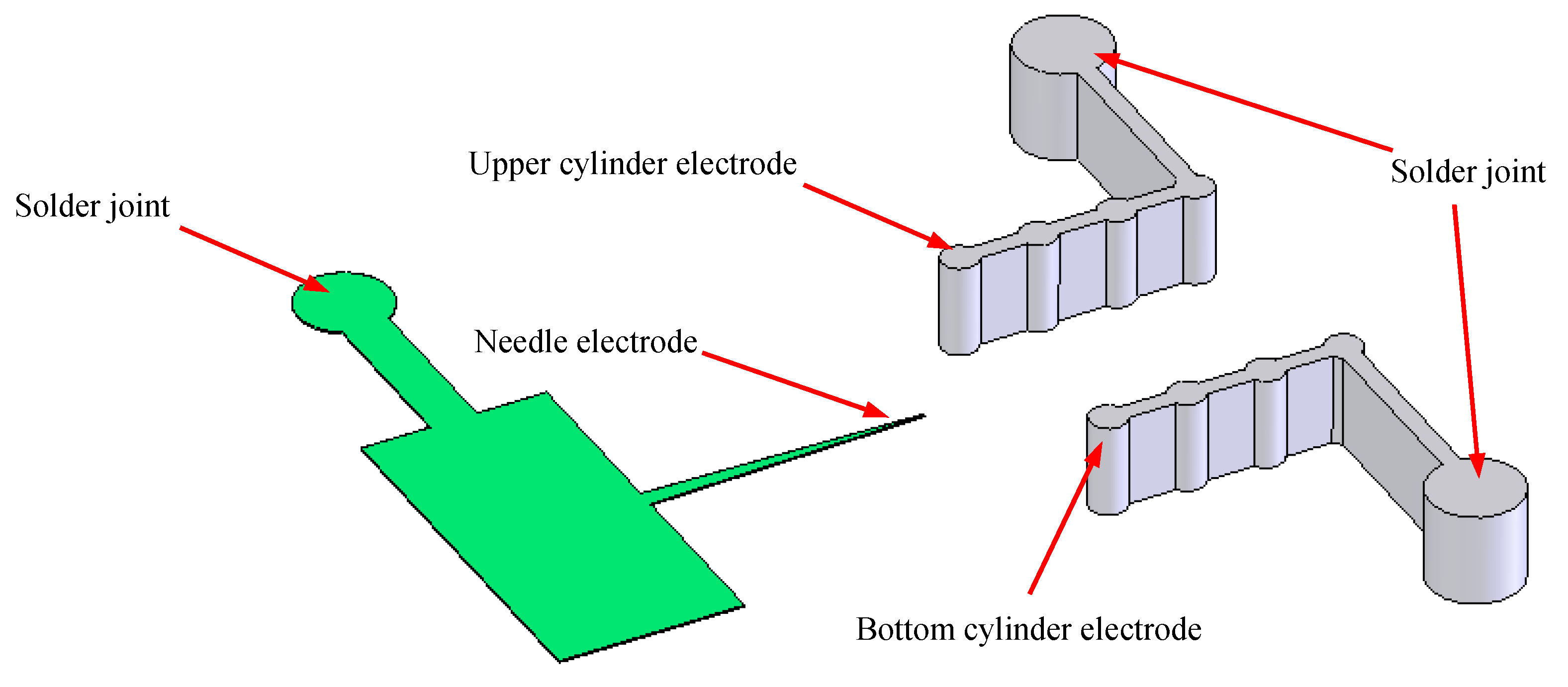
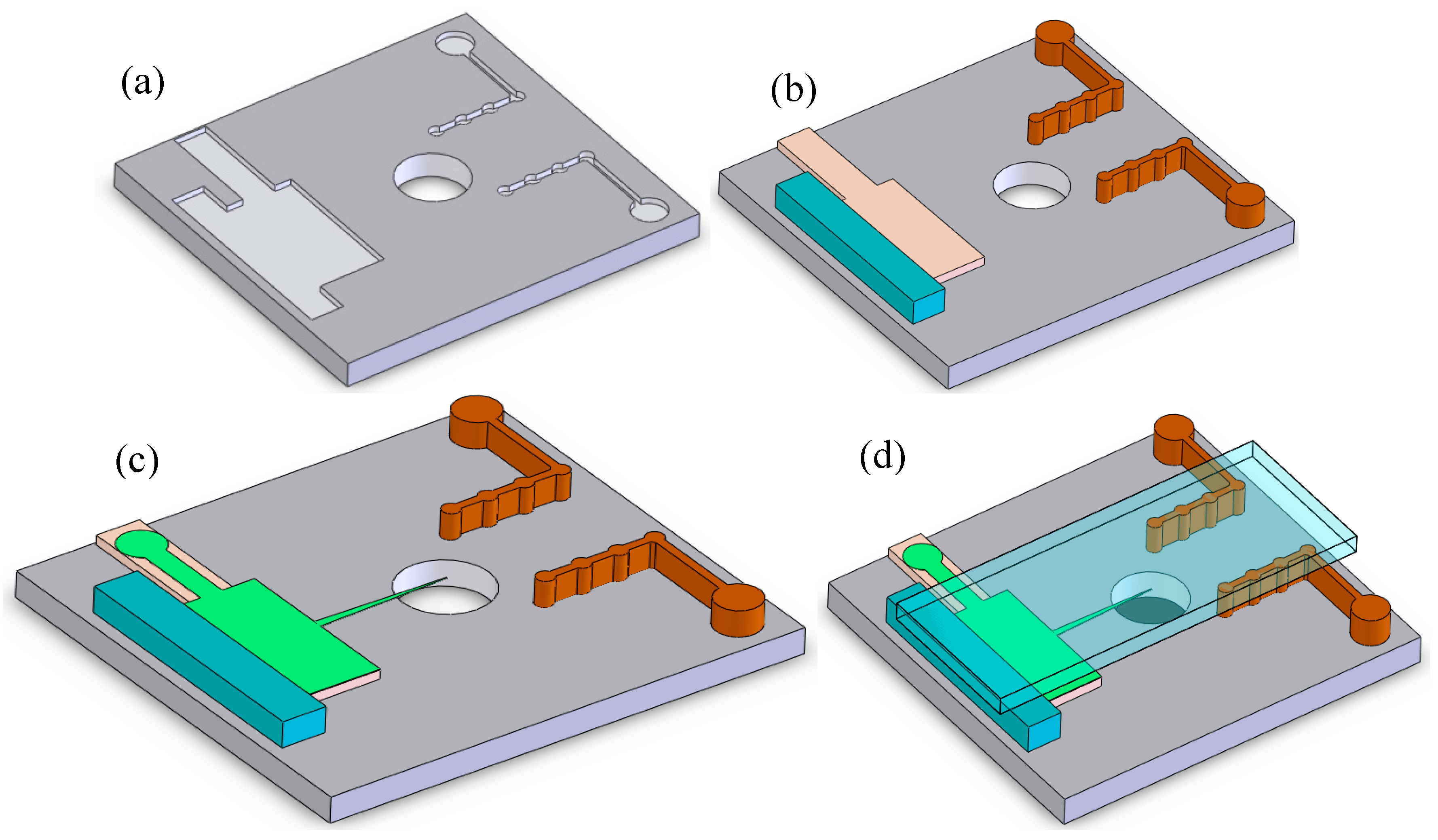
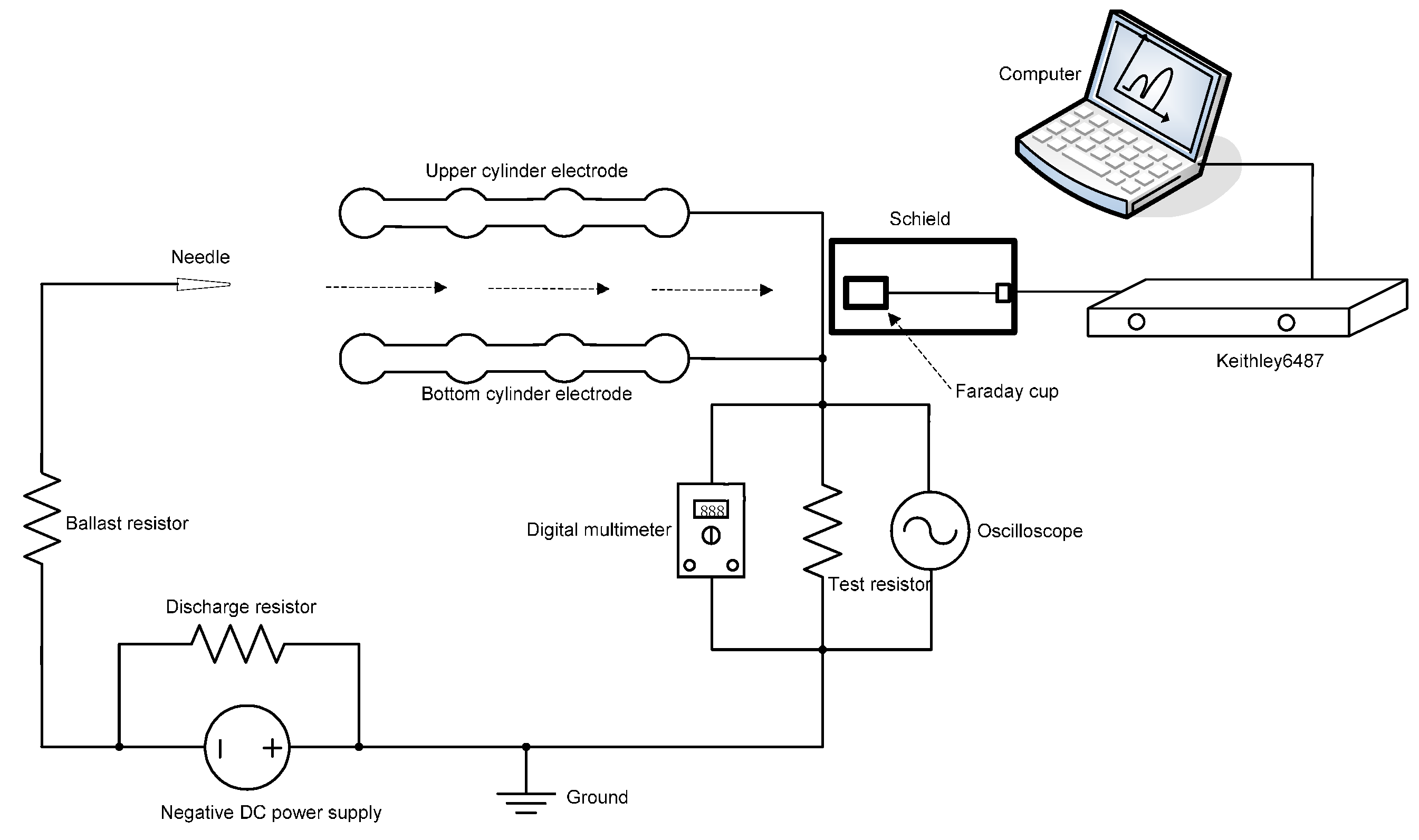


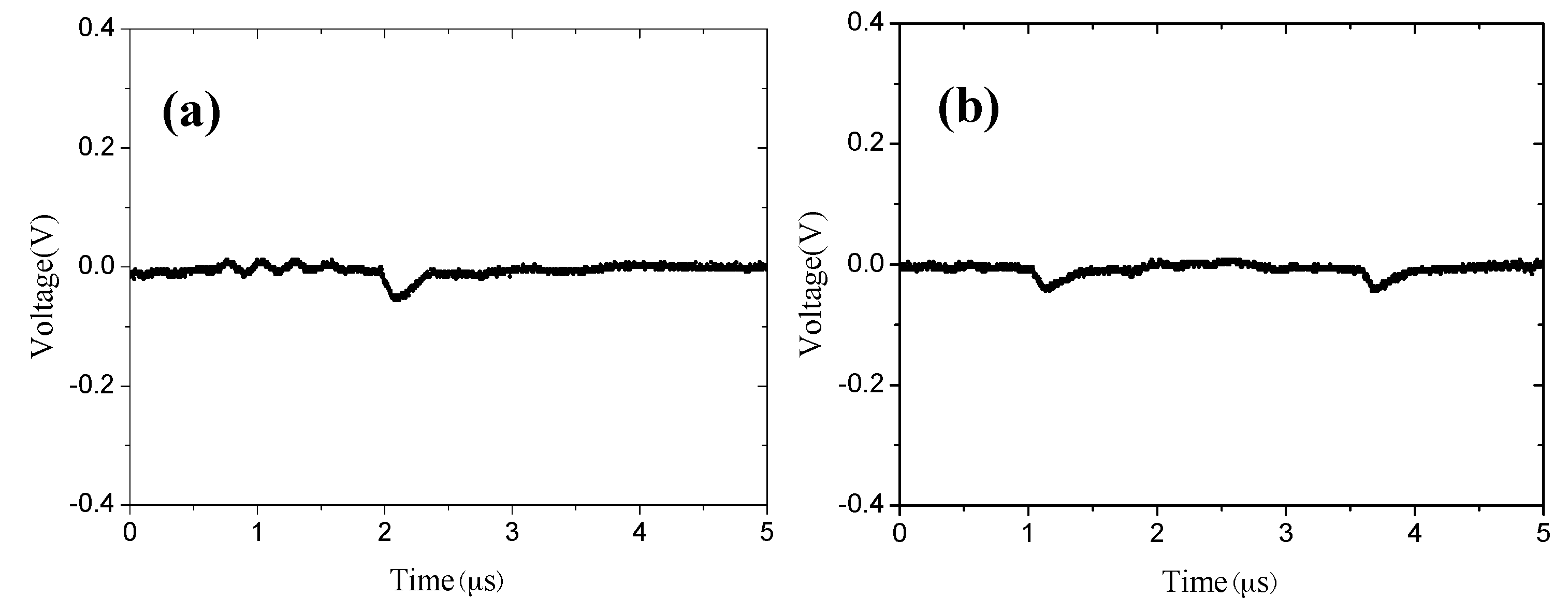

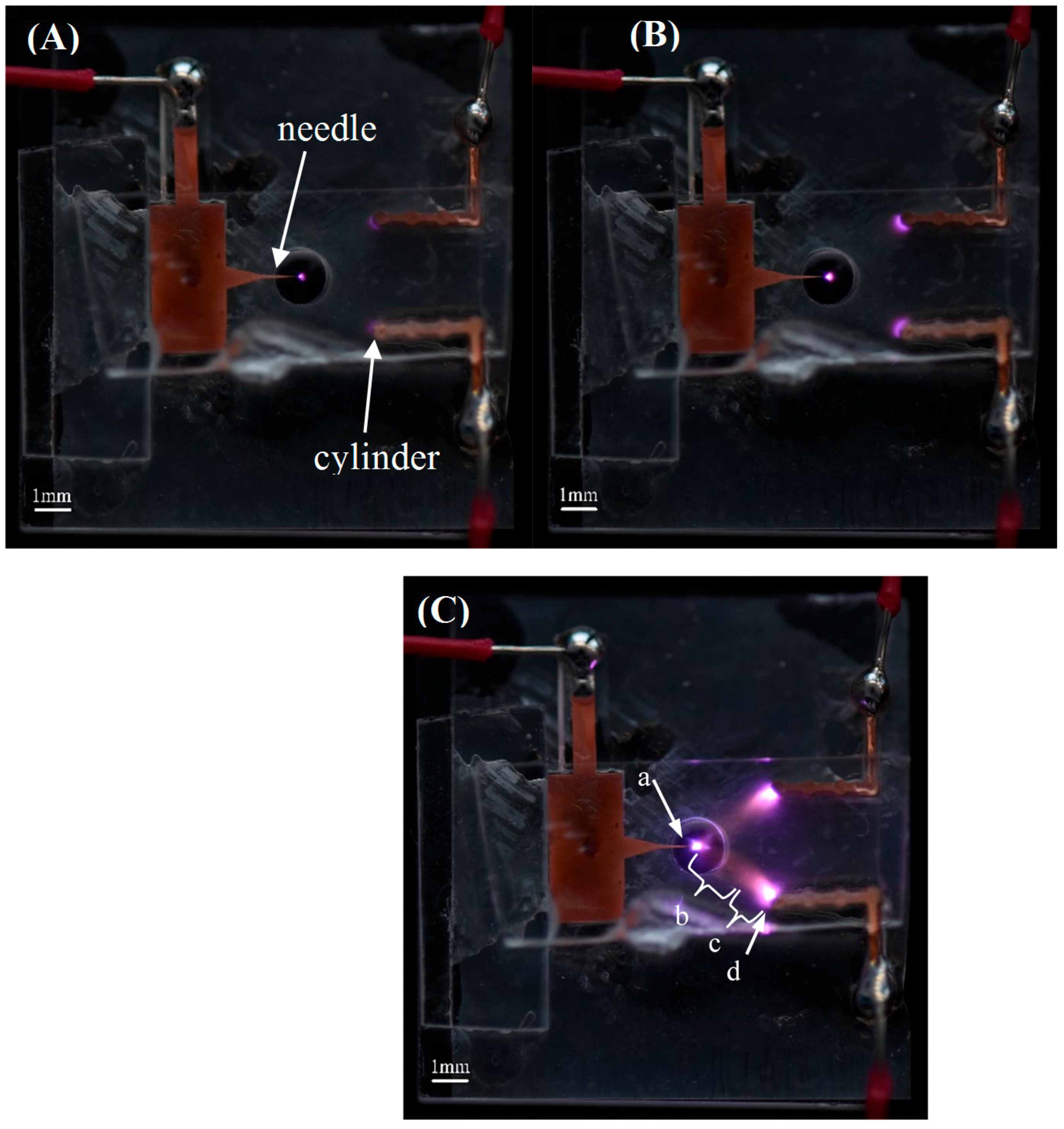

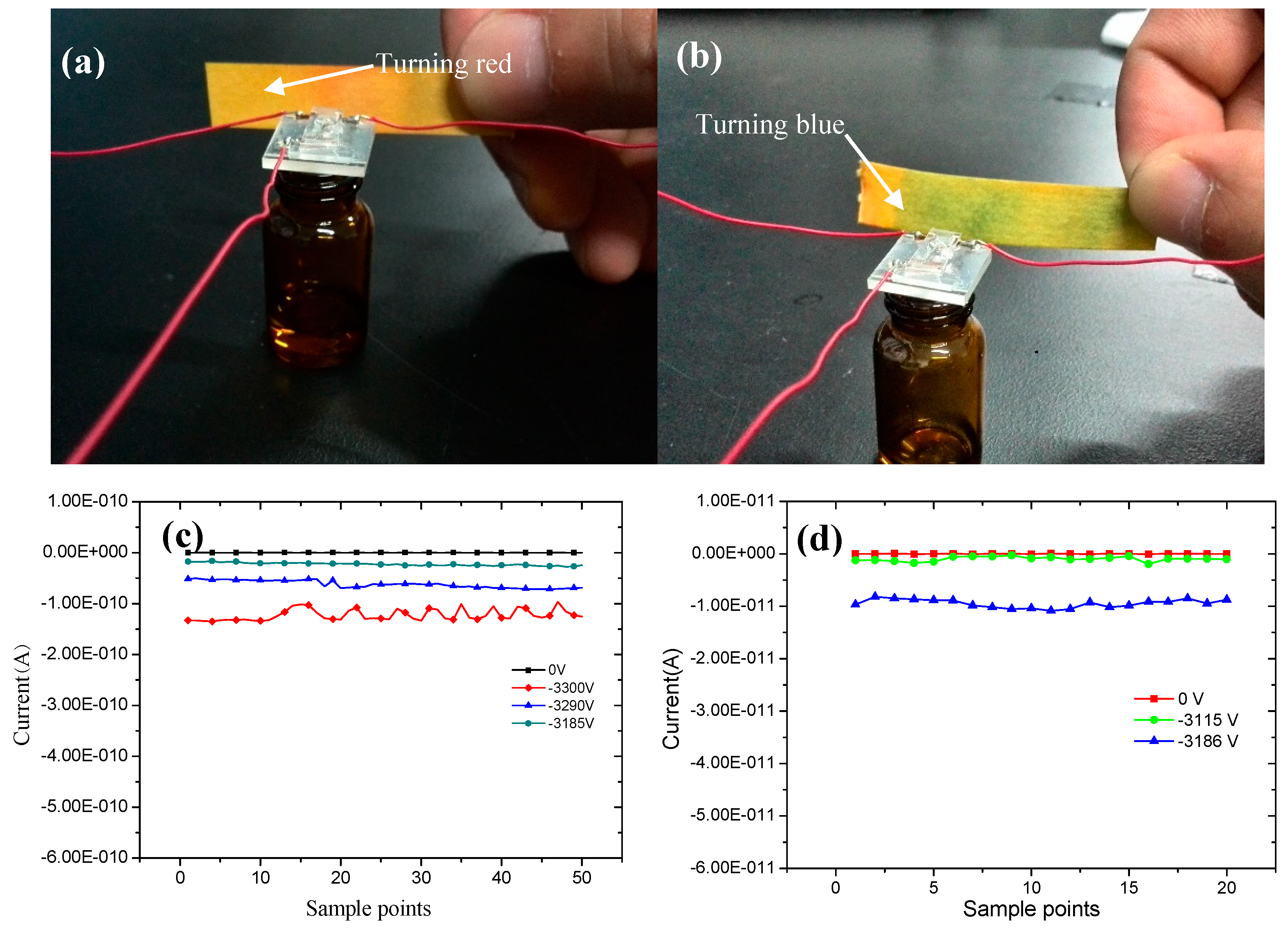
| Features | Dimensions | Features | Dimensions |
|---|---|---|---|
| Curvature radius of pin | 10 μm | Thickness of needle | 20 μm |
| Radius of cylinder | 0.2 mm | Thickness of cylinder | 1 mm |
| Center distance between the cylinders | 0.9 mm | Inter-electrode spacing between two array cylinders | 3 mm |
| Radius of injection hole | 0.75 mm | Thickness of substrate of pin electrode | 0.49 mm |
| Height of top substrate | 0.5 mm | Length of pin electrode | 3 mm |
| Height of bottom substrate | 0.8 mm | The whole dimension of the chip | 11 mm × 10 mm × 2.3 mm |
© 2017 by the authors; licensee MDPI, Basel, Switzerland. This article is an open access article distributed under the terms and conditions of the Creative Commons Attribution (CC-BY) license (http://creativecommons.org/licenses/by/4.0/).
Share and Cite
Li, H.; Jiang, L.; Guo, C.; Zhu, J.; Jiang, Y.; Chen, Z. An Integrated Microfabricated Chip with Double Functions as an Ion Source and Air Pump Based on LIGA Technology. Sensors 2017, 17, 87. https://doi.org/10.3390/s17010087
Li H, Jiang L, Guo C, Zhu J, Jiang Y, Chen Z. An Integrated Microfabricated Chip with Double Functions as an Ion Source and Air Pump Based on LIGA Technology. Sensors. 2017; 17(1):87. https://doi.org/10.3390/s17010087
Chicago/Turabian StyleLi, Hua, Linxiu Jiang, Chaoqun Guo, Jianmin Zhu, Yongrong Jiang, and Zhencheng Chen. 2017. "An Integrated Microfabricated Chip with Double Functions as an Ion Source and Air Pump Based on LIGA Technology" Sensors 17, no. 1: 87. https://doi.org/10.3390/s17010087






